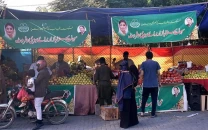Documentation: Cataloguing our forests
Exhibit at Alhamra Art Gallery displays 140 photographs of various forests.

Whispering Hill, a part of Lal Sohanra Park near Bahawalpur, one of Pakistan’s largest reserved forests is spread over 88,400 hectares. It is the country’s largest reserve of wild deer and bird species.
Photographs of Whispering Hill are some of the 140 photographs displayed at the exhibition Forest of Life at the Alhamra Art Gallery on The Mall. It opened on July 10 and shall continue till July 18.
The photographs have been taken by Yasir Nisar, a landscape photographer, sopported by funds from Engro Polymer and Chemicals (EPCL). Nisar says he took over 40,000 photographs of 10 types of forest cover in the country for the project.
EPCL began its Go Green drive in 2009, declared International Year of Forests by the United Nations, and has planted 635 acres of forest in the galliyat and mangroves in Sindh.
Spread across three halls in the gallery, the photographs include the conifer forests of the Ayubia National Park, the chilghoza pines of the Chitral Gol Park, Fairy Meadows, autumn in Hunza, summer in Skardu and Shandur, the Khal Maghsi desert in Balochistan, apricot gardens in Swat and Margalla Hills,.
Sara Aziz, an EPCL communications officer, had accompanied Nisar in the photography expeditions from May 2011 till June 2012.
Aziz said the display is a platform to show the variety of forest cover in Pakistan. “Forest cover is now less than four per cent of country’s total area,” she said.
Aziz has been researching forest zones in collaboration with the IUCN, Pakistan and WWF, Pakistan.
“No group had documented all the forest zones in Pakistan. This is the first project to do so,” she said.
Nisar said 80 per cent of the photographs used in the display were taken after May 2011.
“We also used some old pictures since it is impossible to capture various seasons in each forest over a single year,” he said.
“We visited Shandur in early summer last year. It was very difficult to photograph since there were barely any people there.
It is hard to get through nights without proper camping equipment since temperatures fall to 10 degrees Celsius below zero,” he said. “It is a tough terrain to survive.”
“Kalam’s conifer forests and the deodars of the Neelum Valley in Kashmir are fast deteriorating,” he says. “Locals have no electricity supply. They chop trees for fuel.”
He said that he saw no wild bears in Deosai despite staying there for a week. “I had spotted them within two days when I visited in 2006 and 2009,” he said.
The exhibition will be taken to Karachi and then Peshawar after Ramazan.
The landscape of Khyber Pakhtunkhwa is rich in forest varieties. Displaying the photographs in Peshawar is perhaps more important than exhibiting them in Islamabad, Aziz said.
Aziz said that some visitors had encouraged them to conserve forests. The Fisheries DG and Wildlife DG had visited the exhibition on July 10 and shown interest in the project, she said.
Published in The Express Tribune, July 15th, 2012.



















COMMENTS
Comments are moderated and generally will be posted if they are on-topic and not abusive.
For more information, please see our Comments FAQ